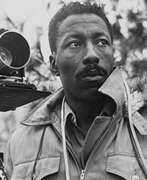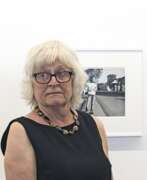Writers Black & white photo


Ansel Easton Adams was an American photographer and environmentalist, celebrated for his black-and-white images of the American West, particularly Yosemite National Park. His profound connection with nature was not only the subject of his art but also the essence of his environmental advocacy, earning him a revered place in both the art and conservation worlds.
Ansel Adams' early exposure to the beauty of nature and a supportive family environment nurtured his dual interests in music and photography. His photographic journey began with a simple Kodak Box Brownie camera, which he used during his early visits to Yosemite, a place that would become the central theme of his life's work. Ansel Adams' dedication to photography and the environment was interwoven, as he utilized his art to advocate for the conservation of America's natural landscapes.
In the 1930s, Adams co-founded Group f/64, advocating for photographic purity and sharpness of focus, principles that would define his work. His role in establishing the photography department at the Museum of Modern Art in New York underscored his commitment to elevating photography as a respected art form. Ansel Adams' work has been exhibited in prestigious institutions such as the Smithsonian American Art Museum and MoMA, showcasing his contributions to American art and environmentalism.
For collectors and art experts, Ansel Adams' legacy transcends his iconic images; it lies in his ability to merge aesthetic excellence with a passionate message of environmental stewardship. His photographs not only capture the grandeur of landscapes but also serve as a timeless call to preserve the natural world.
To delve deeper into the world of Ansel Easton Adams and stay updated on new product sales and auction events related to his work, signing up for updates is a step toward embracing the heritage of a pivotal figure in art and environmental advocacy.
Join our community of art and antique enthusiasts to honor Adams' vision and ensure his message continues to inspire future generations.


Margaret Bourke-White was an American photographer and photojournalist. She studied photography at the Clarence H. White School of Photography. White, where she developed her trademark style using dramatic angles and strong contrasts of light and shadow.
Burke-White was one of the first women photographers to work for Life magazine, and her images became synonymous with the magazine's coverage of major world events such as World War II and the Korean War. She was also the first woman photographer to work in war zones during World War II, where she captured powerful images of warfare and its impact on civilians.
In addition to war photography, Bourke-White also documented the Great Depression in the United States and was one of the few photographers to gain access to the Soviet Union in the 1930s where she documented Soviet industrialization and the lives of ordinary people.
Bourke-White's work was known for its powerful impact and stark realism. She often risked her safety to get the perfect shot and her images continue to inspire photographers today. She published several books of her work, including 'Eyes on Russia' and 'Dear Fatherland, Rest in Peace'.
Bourke-White left behind a legacy as one of the greatest photojournalists of the 20th century.


Gaspard-Félix Tournachon, known by his pen name Nadar, is a French photographer, cartoonist, journalist, writer and balloonist.
Throughout his career, Nadar shot portraits of many famous personalities, including writers, artists, musicians and politicians. Among them were Victor Hugo and Charles Baudelaire, Sarah Bernhardt and George Sand. Nadar's portraits were in great demand as he had a unique ability to reveal the inner essence of his subjects, revealing their character and emotions.
In addition to portraiture, Nadar was an aerial photographer, using hot air balloons to capture breathtaking images from high above. His boldness and adventurous spirit led him to explore new perspectives and techniques, making a significant contribution to the development of aerial photography. In 1858, he became the first person to take aerial photographs.


Edward Quinn is an Irish photographer famous for his portraits of celebrities and artists.
Edward Quinn began his career as a photojournalist, covering events such as the Spanish Civil War and the Second World War. In the 1950s he moved to the French Riviera and began photographing the rich and famous — Pablo Picasso, Brigitte Bardot, Grace Kelly, Max Ernst, Alexander Calder, Francis Bacon, Salvador Dali, Graham Sutherland, David Hockney.
Quinn's photographs are noted for their naturalness and spontaneity. He had a talent for capturing his subjects in inconspicuous moments and revealing their true essence. His portraits often show his subjects relaxed and at ease, as if they were unaware of the camera's presence.
In addition to photography, Quinn was also a writer and filmmaker. He wrote several books about the French Riviera and made a documentary about Pablo Picasso.


Jindřich Štyrský was a Czech artist, photographer, poet, and writer. He is best known for his contributions to the Surrealist movement in Czechoslovakia during the 1930s and early 1940s.
Štyrský initially trained as a painter, but he soon became interested in photography and began experimenting with the medium in the early 1920s. He became associated with the Czech Surrealist Group in the mid-1930s and became one of its leading figures, alongside fellow artist and writer Toyen.
In addition to his photography, Štyrský was also a prolific writer and poet. He published several books of poetry.
Štyrský's photography is characterized by its surreal and dreamlike qualities, often featuring distorted figures and strange juxtapositions of objects. He also produced a series of photomontages, which combined different photographic elements to create unsettling and enigmatic images.
During World War II, Štyrský was persecuted by the Nazi regime for his art and writings. His work has since been recognized for its contribution to Surrealism in Czechoslovakia and its unique blend of photography, painting, and literature.


David Yarrow is a British photographer, conservationist and writer.
At the beginning of his career Yarrow photographed sports stars, at the age of only 20 he took the iconic picture of soccer player Diego Maradona, but then he found his niche. David Yarrow reinvented wildlife photography with his extraordinary patience and, most importantly, his reverence for it. Yarrow's black-and-white wildlife photographs with stars such as Cindy Crawford and Cara Delevingne have brought him ever-growing popularity among collectors. Today he is the best-selling photographic artist in the world.
Yarrow is also active in his charity work for the protection of wildlife.















